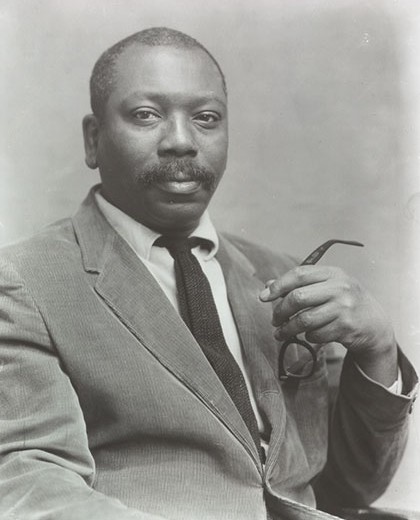Discovering the Artist
Jacob Lawrence
Jacob Lawrence
Jacob Lawrence ( 1917 – 2000) was an African-American painter known for his portrayal of African-American life. As well as a painter, storyteller, and interpreter, he was an educator. Lawrence referred to his style as "dynamic cubism", though by his own account the primary influence was not so much French art as the shapes and colors of Harlem. He brought the African-American experience to life using blacks and browns juxtaposed with vivid colors. He also taught and spent 16 years as a professor at the University of Washington.
His art appears in a vector format or flat, using opaque colors. This gives his art a graphic dynamic to it allowing the eye to move quickly back and forth across the canvas. As a narrative painter, there are multiple stories going on within each painting.
Bootleg Whiskey by Jacob Lawrence
Lawrence is among the best-known 20th-century African-American painters. He was 25 years old when he gained national recognition with his 60-panel Migration Series,[3]painted on cardboard. The series depicted the Great Migration of African-Americans from the rural South to the urban North. A part of this series was featured in a 1941 issue of Fortune. The collection is now held by two museums: the odd-numbered paintings are on exhibit in the Phillips Collection in Washington, D.C., and the even-numbered are on display at MOMA in New York. Lawrence's works are in the permanent collections of numerous museums, including the Philadelphia Museum of Art, the Museum of Modern Art, the Whitney Museum, the Phillips Collection, Metropolitan Museum of Art, the Brooklyn Museum, and Reynolda House Museum of American Art. He is widely known for his modernist illustrations of everyday life as well as epic narratives of African American history and historical figures.
Migration Series
Migration Series
During participation in community art workshops, Lawrence quickly discovered his love of art through the encouragement of teachers such as painter Charles Alston. Throughout the 1930s, Lawrence’s art was inspired by the cultural visionaries of the Harlem Renaissance. In 1938, Lawrence had his first solo exhibition at the Harlem YMCA and started working for the WPA Federal Art Project. In 1940, he received a grant from the Rosenwald Foundation to create a 60-panel epic, The Migration of the Negro (now known as The Migration Series); when the series was exhibited at Edith Halpert’s Downtown Gallery the following year, the then 23-year-old artist catapulted to national acclaim.
In the ensuing decades, Lawrence continued to create paintings drawn from the African American experience as well as historical and contemporary themes, such as war, religion, and civil rights. He taught with Josef Albers at Black Mountain College in North Carolina in 1946 and later at the Skowhegan School of Painting and Sculpture in Maine. He moved to Seattle in 1971, teaching at the University of Washington until 1983. During his later years, Lawrence worked in a variety of media, including large-scale murals, silkscreen prints, and book illustrations. Until his death in 2000, Lawrence honed a unique visual language of abstraction that remained steeped in the human condition.
Harriet Tubman Series
Honoring Harriet Tubman
Born a slave on the Eastern Shore of Maryland, Harriet Tubman escaped to freedom and ultimately made her way to Philadelphia, Pennsylvania. During the 1850s and 1860s, she courageously returned to the South nineteen times, helping more than three hundred slaves escape to freedom in Canada.
Traveling under the cover of night, Tubman used the North Star as a guide and followed the Underground Railroad, a network of people that helped slaves escape to freedom. By day, the slaves hid secretly in houses along the route. Risking her life to liberate others, Tubman demonstrated strength, courage, tenacity, and self-sacrifice. She worked as a nurse during the Civil War and later as an advocate for the rights of African Americans and women.
Harriet Tubman Series
In 1939 and 1940 Lawrence created a series of thirty- one panels that describe moments in Tubman’s life. He revisited the subject in 1967, when he wrote and illustrated the children’s book Harriet and the Promised Land and created independent paintings such asDaybreak — A Time to Rest.






